
Overture
Here is a million-dollar baby. Maybe.
This is the picture: Male, five-eleven, the muscular physique of “Mr. America” and brooding, dark good looks reminiscent of the late James Dean.
Talents: Acting and singing.
Personality: Partly cloudy, with occasional thunder.
Name: Rod Lauren.
And maybe he will be the biggest star of the coming decade.
– “Birth of a Star” by Martin Cohen
TV-Radio Mirror, October 1960
On the day he was born – on March 26, 1939,1Numerous articles give the year as 1940, but his official birth record shows this date in 1939. Whether this was an attempt by a publicity person to shave 365 days off his age to appeal to a younger audience or simply a typographical error repeated several times is lost to the ages. in Fresno – his parents named him Roger Lawrence Strunk.2Confusingly, Roger’s official entry in the Fresno County birth records for 1939 clearly shows his name on arrival as Rogers Laurence Strunk, and his father as Laurence Jess Strunk, both of which appear to be errors. (His mother’s name is spelled correctly in the entry.) To add to the confusion, Roger’s name in the 1940 federal census appears to have been reported – by his mother – as Rodgers T. Strunk. By the time he reached the legal age to drink and vote, he would be heard on radio stations across the United States (as well as in Canada, Great Britain and several other countries), written about in newspapers and magazines – from his hometown Tracy Press to Life, Time, and Parade – and seen on national television with Ed Sullivan, Bob Hope, Perry Como, Steve Allen and on Dick Clark’s “American Bandstand,” known now as the “moody, sullen-faced”3As described by Lloyd Shearer in his profile of Rod Lauren in the December 20, 1959, edition of Parade. Rod Lauren.
This is the story of Rod Lauren, and of Roger Strunk.
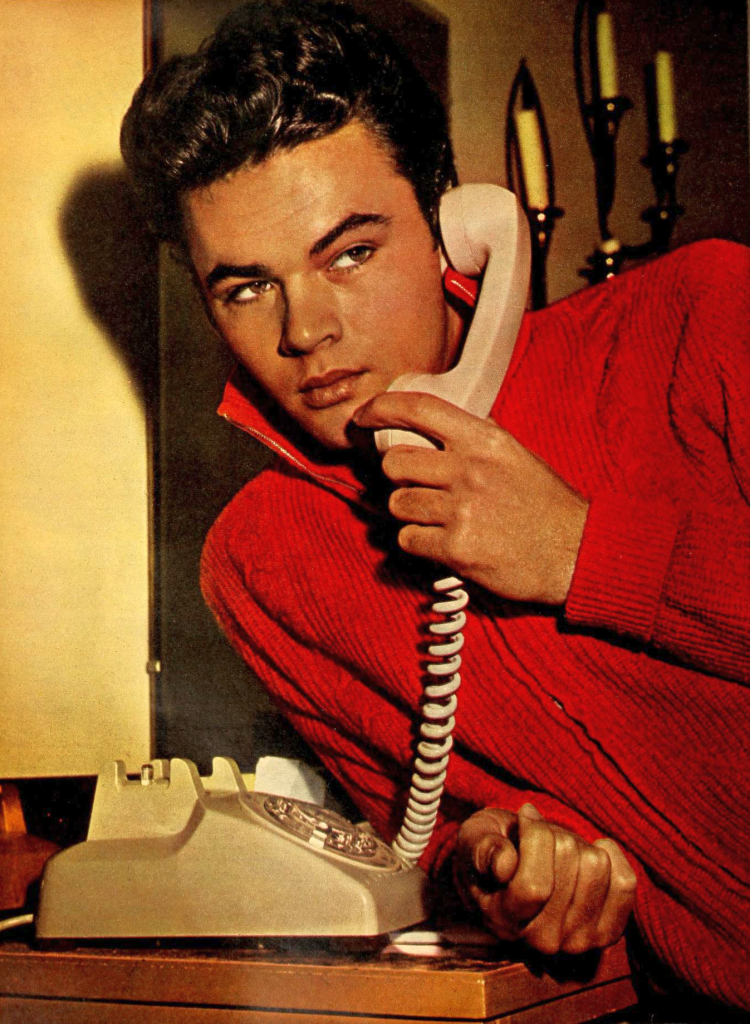
By the time Roger Strunk turned thirty, the life that had been planned for him as Rod Lauren had begun to fade. He had recorded a few dozen songs on two labels, including RCA Victor, which had discovered him in 1959 and aimed him toward stardom – hoping he might fill the void left by his RCA stablemate, Elvis Presley, who was off in Germany and away from the recording studio while serving his two-year hitch in Uncle Sam’s Army.
Roger – or, rather, Rod Lauren – wasn’t chosen to replace Elvis as an imitator. While Elvis could growl or croon, sing it loud and rough or soft and sweet, Rod hewed closer to Johnny Mathis in style, with a smooth, melodic vocal range that worked best on soft, romantic tunes or light, poppy numbers.
But Rod – or, rather, Roger Strunk – didn’t start out with the goal of being a pop singer. Sure, he had a wonderful voice and he certainly knew how to sing (because simply having a good voice doesn’t necessarily make you a good singer), played the trombone in the school jazz band (his mom was an accomplished music teacher), and he was also a pretty good athlete (a varsity baseball player in high school, he also played basketball and football, and was the state’s junior archery champion at age 16.4Junior archery champion, according to a Rod Lauren profile syndicated by Gilbert Youth Service, published August 1, 1963.)
Roger’s parents had wanted him to become a dentist.
Roger wanted to be an actor.
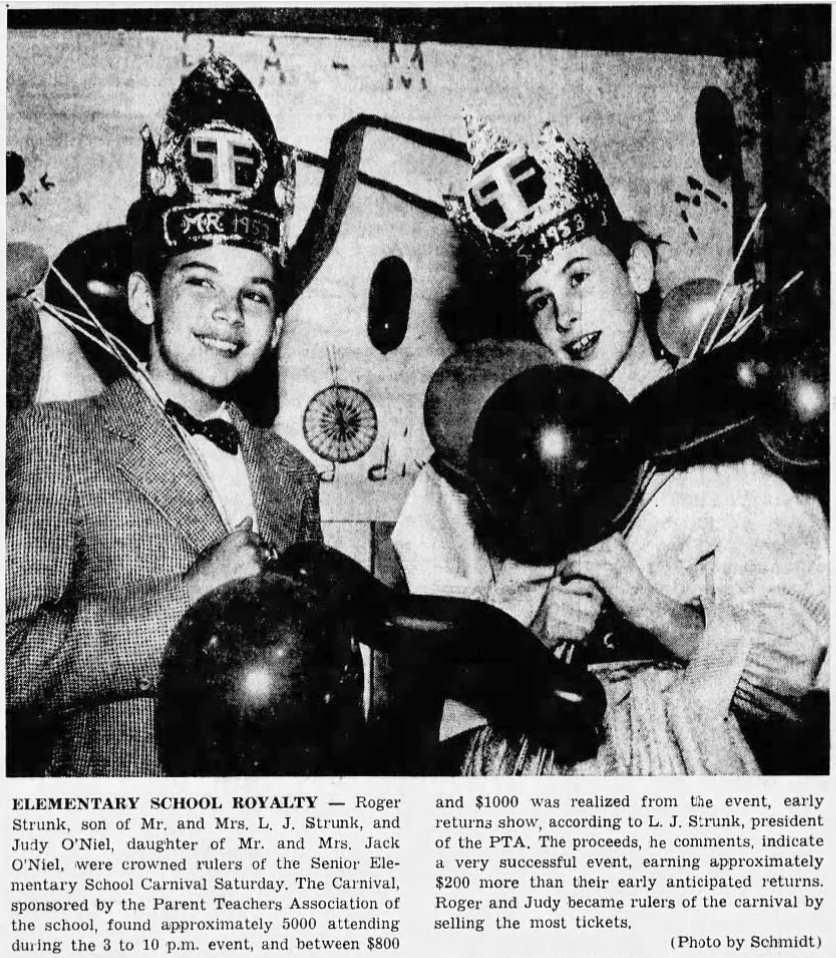

Act One
In 1942, when Roger was about three years old, his parents relocated their little family – which now included new baby sister Sharolyn – from Fresno to little Tracy, Calif., on the west side of the San Joaquin Valley, just over the Altamont Pass from the San Francisco Bay Area.
Tracy (population just over 4,000 in 1940) was a pocket-sized version of Fresno (population just over 60,000 in 1940) – a town built around a busy railroad junction, surrounded by small, comfortable homes built primarily for the railroad’s workers, and surrounded by dairy farms and fields of alfalfa, tomatoes, beans, and other seasonal crops that grew well in the rich soil and could be shipped quickly by rail to points east.
Roger’s dad, Larry, was a switchman for the Southern Pacific Railroad, whose bustling Tracy yard was located right in the center of the city’s bustling downtown. Transferring from Fresno to Tracy, Larry worked for the SP for three years before becoming a teacher at West Park School in his new hometown.

Meanwhile Mrs. Strunk – Helen – kept the family home running while keeping an eye on Roger and his new little sisters, Sharolyn (born in 1942, who would be known as Sharry) and Tamara (born in 1943, who would be known as Tammy).
The family of five settled into a small, comfortable home on Whittier Avenue in the Parker Acres tract, one of the city’s first residential districts. In 1948, Larry gave up teaching and returned to his work as a switchman with the Southern Pacific, a good, well-paying job that came with a full menu of union benefits.
Once Roger, Sharry and Tammy were attending school on a daily basis, Mrs. Strunk also headed back to the classroom, first at several schools as a substitute teacher, followed by a year at West Park and two years at the old Naglee School, located north of town near Old River. In 1955, Mrs. Strunk moved to the Jefferson School in Tracy’s Carbona district, beginning a long career teaching music, and third and sixth grades. (She retired in 1974.)
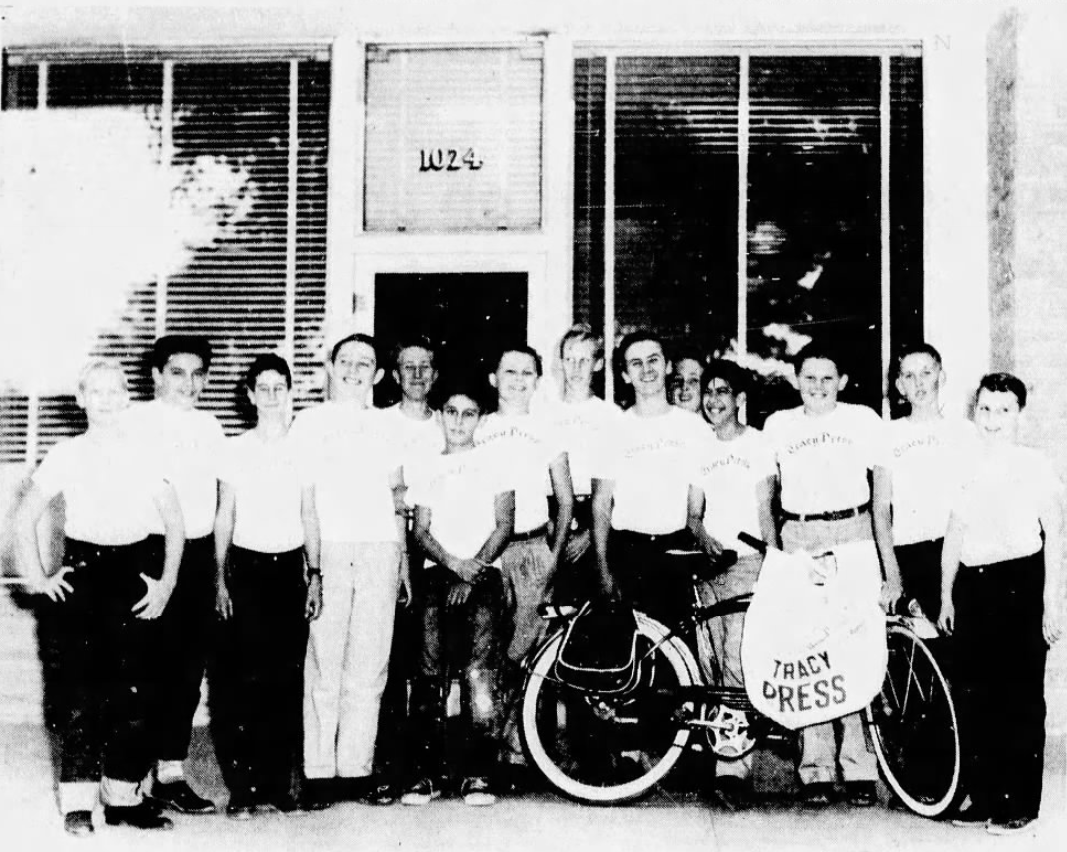
Among Mrs. Strunk’s earliest students were her own three children, each of whom was musically inclined. The Strunk kids were popular and very much involved in their community, as were their parents; dad and mom were involved in various local organizations, including the PTA, DeMolay and their church, where Mrs. Strunk was the organist and Mr. Strunk added his voice to the choir.
As a kid, Roger played Little League baseball and “lightweight” flag football, won the schoolboy free-throw shooting championship in 1953 (hitting 19 of his 25 shots) and had a paper route, delivering the Tracy Press in his neighborhood.
All three Strunk siblings attended Senior Elementary School (a “middle school” or “junior high,” easing the transition from grade school to the next level) and what was the city’s lone secondary school at the time, Tracy Union High School – and each did quite well academically and socially, taking part in numerous extracurricular activities, including community service, sports, music and theater – three bright, good-looking kids with easy, winning smiles and outgoing personalities.

Was he a perfect kid? In his own words, no.
Looking back on his childhood from a few years distance, he told Teen Screen magazine5“Rod Lauren: America’s Greatest Undiscovered Talent,” as reported by Jack Holland. in November 1962:
I always knew I was loved as a child, but I was a pretty independent character. My father made me accept responsibilities for my actions. If I got in trouble, I had to get out of it myself. I also had to work for everything I got. I did such odd jobs as mowing lawns, being a paper boy, serving as apprentice in a printing shop, working in a gas station at nights. What I wanted I had to buy – except for one thing and I can never forget it. One Christmas when I was a kid my father bought me a bicycle. I was as excited over it as if it had been a Mercedes-Benz. I kept that bike shiny as the day I got it.
I was not what you’d call the ideally behaved youngster, though. When I was three, for instance, I’d start to wander away from home. It wasn’t that I meant to away – I’d just begin walking and I’d be two or three miles from home before I knew it. The police were always picking me up and taking me back, and I can still recall the lickings my grandmother would give me when I walked in the door. I guess I took these walks because I liked talking to people and because I enjoyed exploring.
I was also a pretty awful tease then. I used to get every mother in the neighborhood mad at me because I’d give their kids a rough time. I had one favorite trick – I’d put dry ice into a pool where the kids were swimming and then say I was going to burn them up. I had a habit of snitching things too. One day I saw a car that belonged to a little boy – the kind you moved by working the pedals. I wanted it so badly I just took it – and I kept it for a week before it was discovered I had it.
I actually didn’t get into any serious trouble, though, except for the time I got into a couple of gang fights and was taken to juvenile court. My father didn’t say a word to me – not one reprimand. He knew I was suffering enough inside for what I’d done. It was his attitude more than anything else that made me wise up finally.
Often, the twice-weekly Tracy Press that Roger Strunk tossed on local driveways (with the skilled arm of an up-and-coming prep hurler) on his paper route carried his name within its pages – a front-page photo in February 1952 shows him beaming from under a jaunty crown, dapper in bow tie and checked sports coat, having been declared king of Senior Elementary’s fundraising carnival (alongside his queen-for-a-day classmate, Judy O’Niel) for having sold the most tickets to the event.
“King” may or may not have been a step up from his being elected as president of the 7/5 class at Senior Elementary, as reported earlier that school year. (The Tracy Press, in its news item announcing the election results, also noted that Rebecca Reymundo was voted in to serve as “gum monitor.”)
Roger shares billing with his sister Sharolyn in the Press’ “In Tracy Society” column in December 1954 – she plays flute as part of the ensemble performing the Nutcracker Suite, and Roger models the latest in clothing style for boys from the downtown J.C. Penney’s store as part of the “Tots To Teens Fashion Show,” all part of a gala fundraiser for Senior Elementary that is held in Tracy High’s auditorium.

Once ensconced at Tracy High, Roger’s name pops up in the Tracy Press with almost clocklike regularity, as a capable pitcher and batter for the Bulldogs’ baseball squad, playing trombone in his alma mater’s orchestra and jazz band, as an actor appearing in a variety of school plays.
Clearly comfortable in front of an audience, he shines in the role of boisterous Uncle Teddy Brewster (who believes he’s actually the Teddy Roosevelt) in the school’s production of the black comedy “Arsenic and Old Lace.” If his time treading the boards in the limelight on Tracy High’s stage hasn’t set him firmly on the path toward a career in TV and movies, nothing ever will.
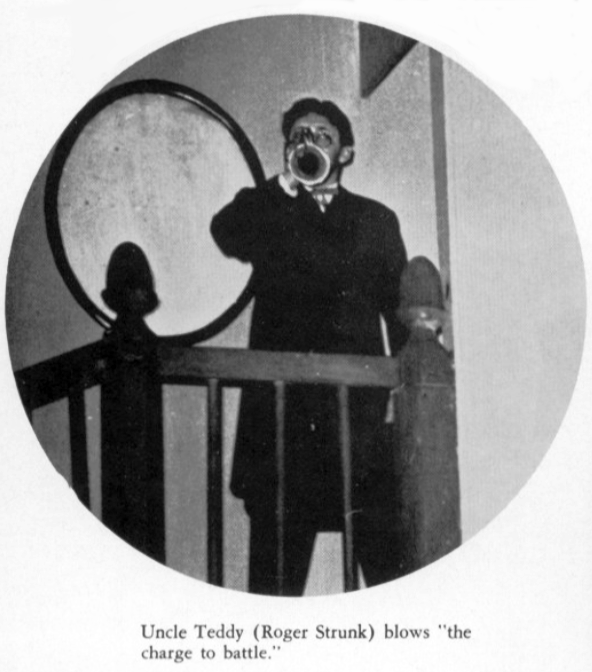
He earned his “Block T,” signifying a varsity Tracy High student-athlete, lettering as a junior during the 1955-56 school year with the Bulldogs baseball team. During that fall’s football season, however, he was only a Bullpup, playing on the “Bee” (junior varsity) gridiron squad. Nonetheless, his name, image and likeness appear a dozen times in that year’s El Portal yearbook for his involvement in nearly every aspect of campus life.
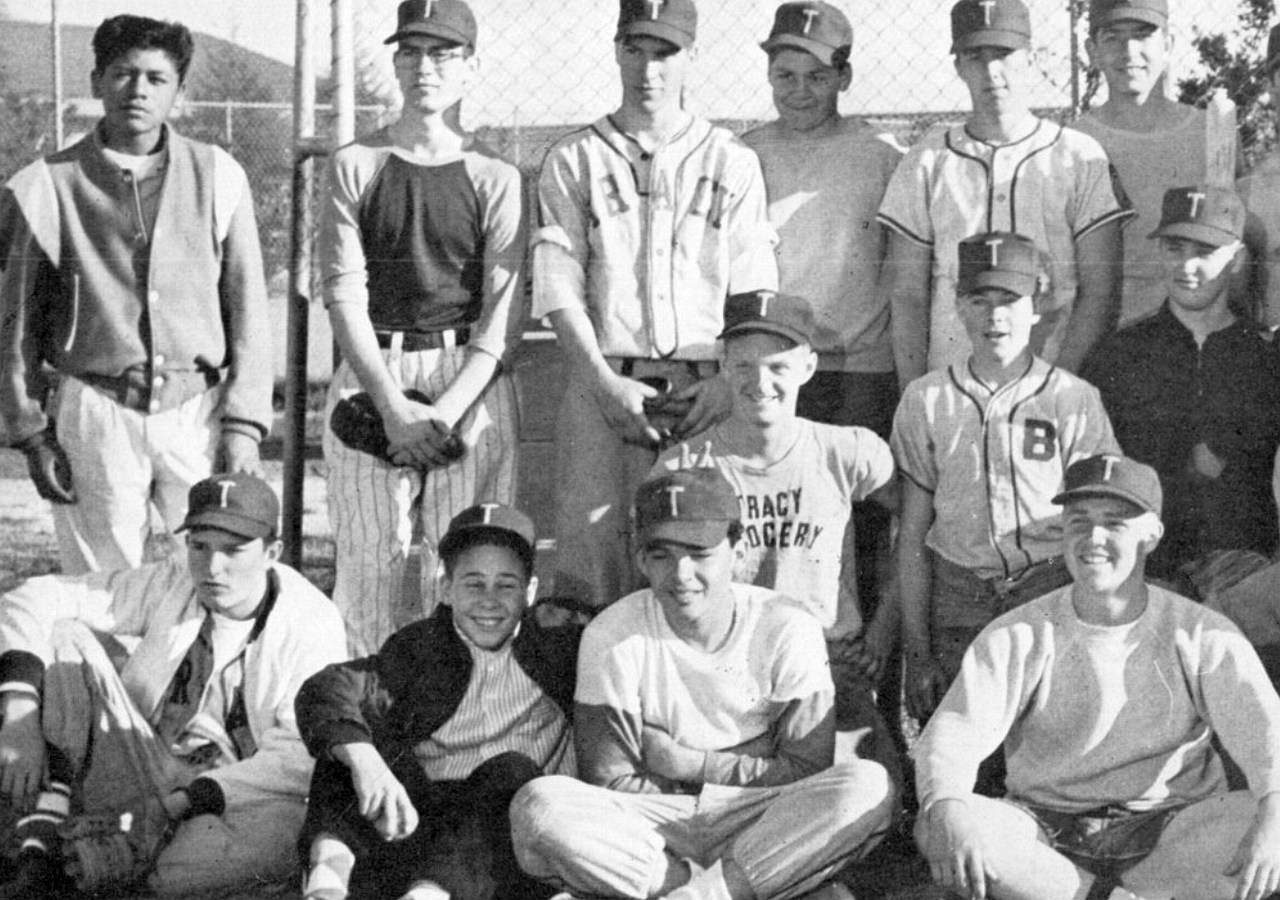
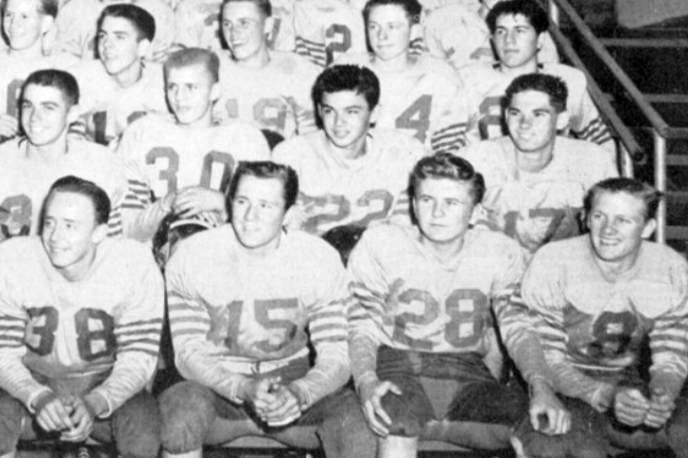
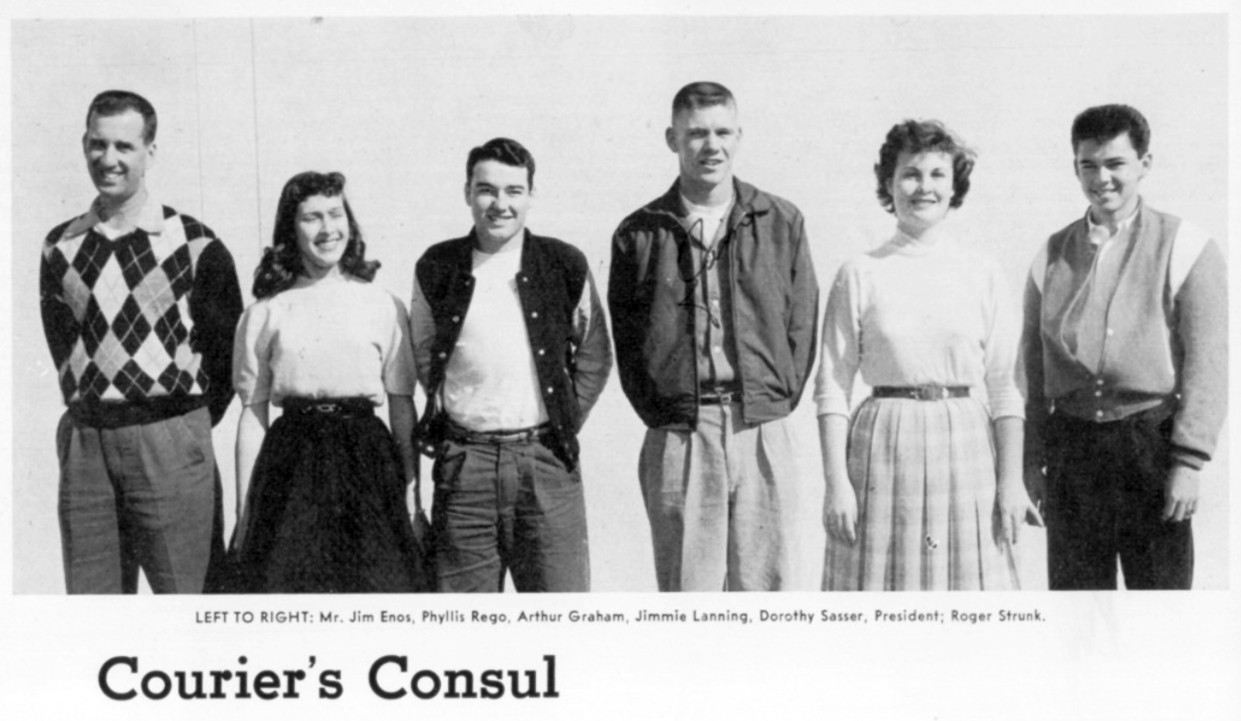
Roger Strunk as a Tracy High junior during the 1955-56 academic year: in the top photo, with his teammates on the varsity baseball team (arms folded, right of center); in the middle photo, wearing #22 as a member of the junior varsity football squad (also right of center); in the bottom photo, as part of the Courier’s Consul (at far right).

Interlude
Listening to his music today, you wouldn’t think that his was the type that would cause a rock’n’roll riot. Little Richard, maybe. Jerry Lee Lewis, possibly.
But you wouldn’t think that the friendly, rollicking, often bouncy barrelhouse style of Fats Domino would cause fistfights, thrown bottles and chairs, arrests by the dozens, and bans imposed by city councils from sea to shining sea, outlawing concerts and dances featuring the portly New Orleans music star from appearing in their municipality.
In the heart of the 1950s, however, that’s exactly what happened when Fats – real first name Antoine (and real last name Domino) – came to your town.
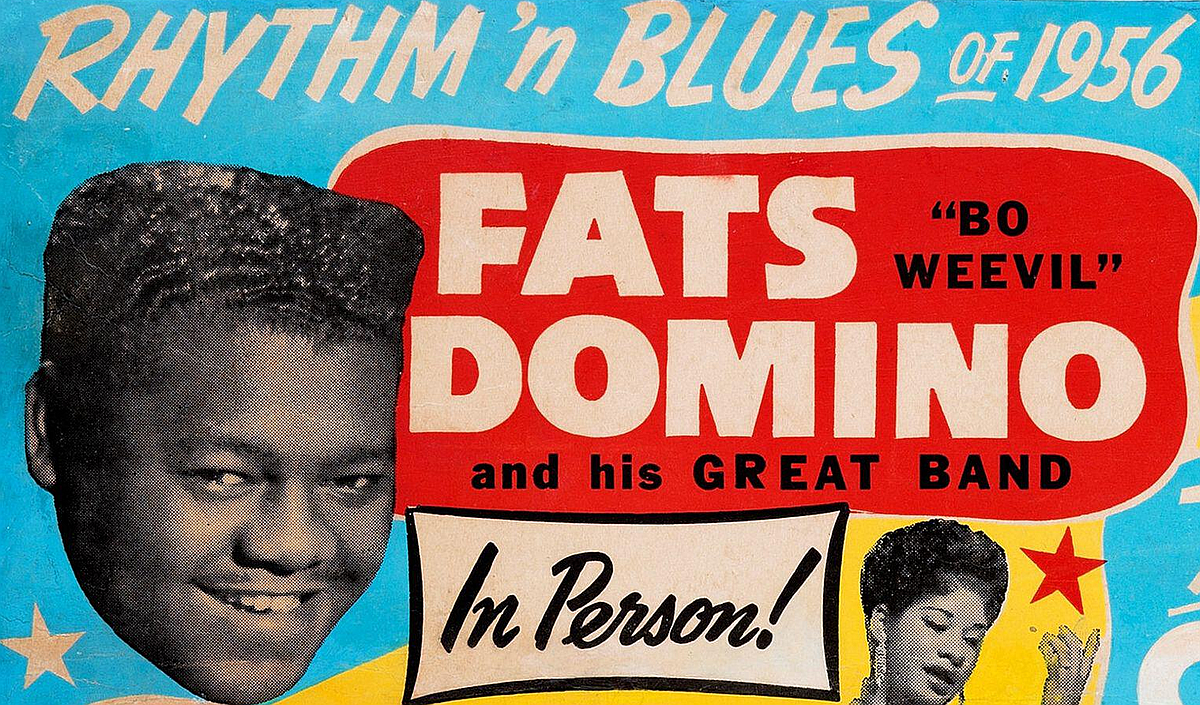
Local law enforcement rarely blamed Fats Domino or his orchestra and their music for the trouble that broke out at his shows – someone in the crowd would say something incendiary to someone else, or someone would give someone else the wrong look, or someone would accidentally brush up against someone else, and all hell would break loose.
The band would try to play on gallantly as the deck chairs were rearranged (or thrown) and bottles would be broken (or thrown) and dukes would be put up (or thrown) but, often, as the metaphoric ship began to sink (on dry land), Fats and his crew would leave the stage and head back to the safety of their tour bus, then hit the road for the next town on their itinerant itinerary, sometimes before the assembled crowd knew they had blown town.
Such was the case in the hot, dry Summer of 1956 in the San Joaquin.
On June 21, down the Valley in Fresno, six young people were placed under arrest and five others were injured when a melee broke out after the Fats Domino show at the city’s Municipal Auditorium.
The Associated Press news story reported that “Officers said a fight started when several youths used abusive language at the dance.” (The story also quoted Domino, who observed “I see great things ahead for this type of music.”)
Regardless of Fats’ prediction, and based on the news reports, city councils and local constabularies begged to differ, blocking promoters from bringing Fats – or any of his ilk – to their towns.
San Jose, however, with a larger police force and supposedly better protections in place, decided to allow the show to go on. They soon regretted it, as 2500 fans piled into Palomar Gardens in San Jose’s downtown and quickly grew impatient as Fats and his eight-piece band failed to show up on schedule. Once they started playing, one beer bottle was thrown, and then another, and then a riot broke out.
“Everybody was at each other,” the manager of Palomar Gardens, Charles Silvia, told the Associated Press. “Boys fought boys, and even girls. Girls were slugging boys and scratching one another.”
It took 75 police officers to get everything under control, by which time Fats and the band had beat a hasty retreat around midnight, leaving thirteen fans in need of medical treatment and nine others in police custody.
According to numerous sources, this was the birth of the now evergreen term “rock’n’roll riot.”
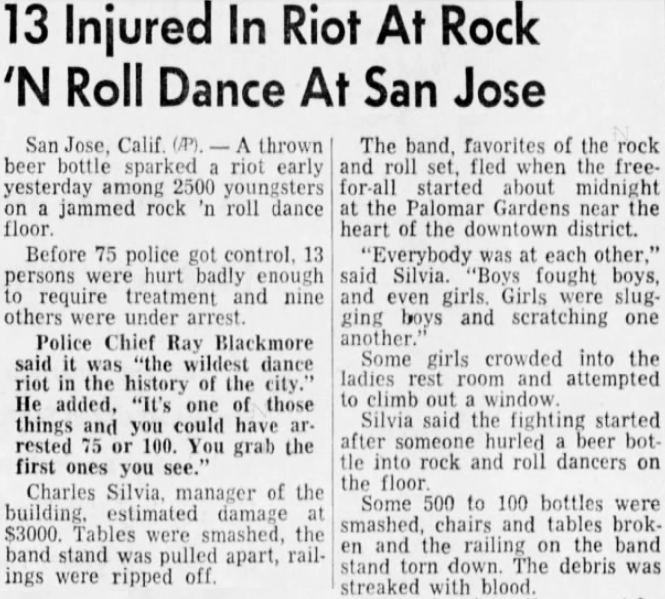
Oakland’s city administrators quickly bailed out on a planned Fats Domino show in the Eastbay’s largest city. The promoters checked their road map for the next-largest burgh in the area, and stuck a pin in the one called Stockton. Nix on that, the Port City’s leadership decreed – they didn’t want Fats or the trouble that he seemed to follow in his wake.
But what about sleepy little Tracy, that quiet farm town on the back end of the Altamont, best known as the last chance to top off the gas tank, have a beer, take one more bathroom break, grab a pack of smokes and then hit the last stretch of road over to Highway 99 on the way to L.A. or Sacramento – any chance Tracy had a dance hall big enough for a thousand or so kids to pile into?
As it turns out, Tracy did.
Today, if you drive around the back side of Tracy’s downtown, along 6th Street, you’ll pass the hind end of the bullfight arena and the IPFES Portuguese Hall. (Don’t worry – the bullfights held at the annual festa are bloodless.)
Back in the 1950s, however, the Portuguese Hall was known as the Tracy Ballroom, home to a variety of civic events, weddings, reunions and the occasional dance. As the warm and getting warmer Summer of 1956 rolled on, George Wescott submitted an application for a “dance permit” to Tracy’s city clerk on behalf of Oakland’s Schwartz Enterprise, which had contracted to promote Fats Domino and his orchestra.
The permit application, which set the event’s date for Friday, July 20, appeared to comply with all local ordinances and regulations and was promptly approved by Tracy city clerk Fred Watkins, but drew the attention of the city council, particularly in light of the earlier Domino-related results elsewhere. However, since all other requirements of Tracy’s dance permit ordinance were met, the permit went through – including the requirement that the promoter pay a $10 per man charge for four police officers and four members of the police reserve unit to be on hand at the event.

Erring on the side of caution, the city council decided the only change they’d require was to increase the police presence. The state, on the other hand, decided that a quartet of officers from California’s nearly-new Department of Alcoholic Beverage Control – established just a year earlier – should also be there, just in case.
In a Tracy Press article marking the sixtieth anniversary of the event, Bill Slayter – later the publisher of the fabled entertainment and culture magazine Zorch! but at the time a 17-year-old kid heading into his senior year at Tracy High – related his recollections to Press publisher emeritus Sam Matthews:
“It was a typical American Graffiti night in Tracy. My cousin, Don Fritz, picked me up at the house on McKinley across from the hospital in his 1948 Ford – a good cruising car and better than my VW. It was down to Henry’s and then down 11th to Central and back, and then down to the Tracy’s Drive In, owned by classmate Richard Patterson’s parents.”
After cruising for a while to kill time, it was off to the ballroom.
“All the Tracy policemen were there, and we knew them well,” Slayter told Sam Matthews. “Also, there were the ABC officers from Stockton. They stood out like they were headed for a Lawrence Welk concert, not a Fats Domino show and dance. Sport coats in Tracy in July!”
“The show was great, and a lot of people danced. We all knew who Fats Domino was, with the exception of the ABC guys,” Slayter recalled, adding that the show ended sooner than expected.
“Afterwards, it was back to cruising. Louie Howerton had the best cruise car, a 1950 James Dean Mercury. Louie’s best friend was Roger Strunk. I can still see them now in that 1950 Mercury.”
According to the Tracy Press, twenty people were arrested at the show, including three who were cited for supplying liquor to minors.
Aside from a few minor skirmishes, no major incidents were reported. Nonetheless, the Tracy city council decided later in the year that the permits for two upcoming events scheduled for the Tracy Ballroom – a December 28 appearance by Little Richard, and a Five Satins show on January 5, early in the new year – should be denied, citing the previous summer’s Fats Domino concert “and the problems it created.”6As reported by the Tracy Press on December 28, 1956 – the day of the scheduled Little Richard show. It is noted that the article tellingly refers to the Five Satins as The Five Satans.
The Fats Domino show in bucolic Tracy remained a touchstone for many years for the more than two-thousand fans who crowded the ballroom that warm summer night in 1956.
Bill Slayter summed it up simply, succinctly:
“Times were good growing up in Tracy in the ’50s,” he said.


On the evening of Wednesday, June 5, 1957, the 149 members of the Tracy Joint Union High School’s Class of 1957 – 88 boys, 61 girls – received their graduation diplomas in front of their assembled families and friends in the high school’s gymnasium.
To the the strains of the Tracy High orchestra, which included Roger’s sister, Sharolyn, the program began with the entrance of the graduating seniors. Following the processional and the presentation of colors and salute to the American flag, the invocation and benediction, a piano solo (“Deep Purple,” performed by Mary Ellen Fairbanks) and the greeting and address by the class’ salutatorian, the Senior Boys Quintet – featuring Roger Lawrence Strunk,7Roger had received his four-year pin from the Band Boosters Club on May 25 in honor of having made it all the way through high school as part of the music program. While not chosen by his peers as “king” at the banquet, a familiar name from his past, Judy O’Niel, was voted queen. his pal Walter Louis (Louie) Howerton, and valedictorian David Campbell Junge – took the stage to perform.
After Junge’s speech and more words by Tracy High’s principal and the head of the school district, the Class of 1957 crossed the stage to receive their diplomas.
High school was over. For each of the nearly 150 young graduates, the future looked bright ahead.
For Roger Strunk, one of two paths appeared certain: the first, and the one preferred by his parents, was dental school.
The second, and the one preferred by Roger, led to the bright lights of Hollywood.
Either way, the road to his future would begin about twenty-five miles directly northeast of Tracy in Stockton – perhaps not the first place one would think of as a stepping stone to Tinseltown, but a wise choice for someone whose life work would involve working on teeth.
After enjoying a few months of freedom during the Summer of 1957 following graduation, Roger enrolled at Stockton College, a “junior college” located in its namesake city, adjacent to the campus of its former parent institution, the College of the Pacific,8Both Stockton College and the College of the Pacific later took on new names. In 1963, Stockton College became San Joaquin Delta College; in 1961, College of the Pacific was renamed the University of the Pacific, the name it used from 1851 until 1911. known locally simply as “Pacific.”
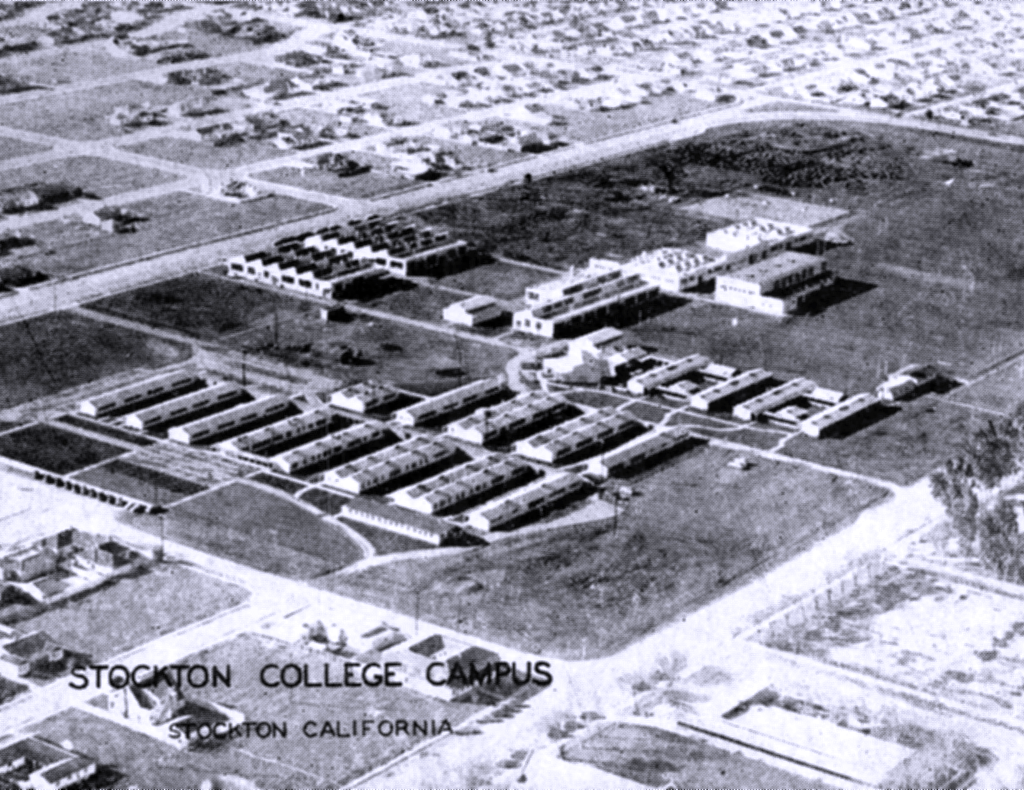
For many decades, Stockton College was affiliated with Pacific, which in turn had a long affiliation with the San Francisco-based College of Physicians and Surgeons – a noted dental school, in spite of its more broadly-encompassing name9Physicians & Surgeons was incorporated fully into the University of the Pacific in 1962, while remaining in San Francisco. It was renamed the Arthur A. Dugoni School of Dentistry in 2004. – which made the college an inviting stepping stone to a career as a dentist, orthodontist or oral surgeon, as Roger’s parents hoped for their son.
No records survive to let us know which course of study Roger Strunk followed in his freshman year at Stockton College – an August 1963 syndicated article10“Young Entertainer Backs Into Acting By Not Talking,” syndicated by Gilbert Youth Service in early August 1963. No byline was included on the article. mentioned that “his majors at first were in math and science, in preparation for dentistry” – or at what point he decided that he needed to follow his heart rather than his parents’ hopes. What we do know is that he spent only one academic year at Stockton before deciding to transfer elsewhere.
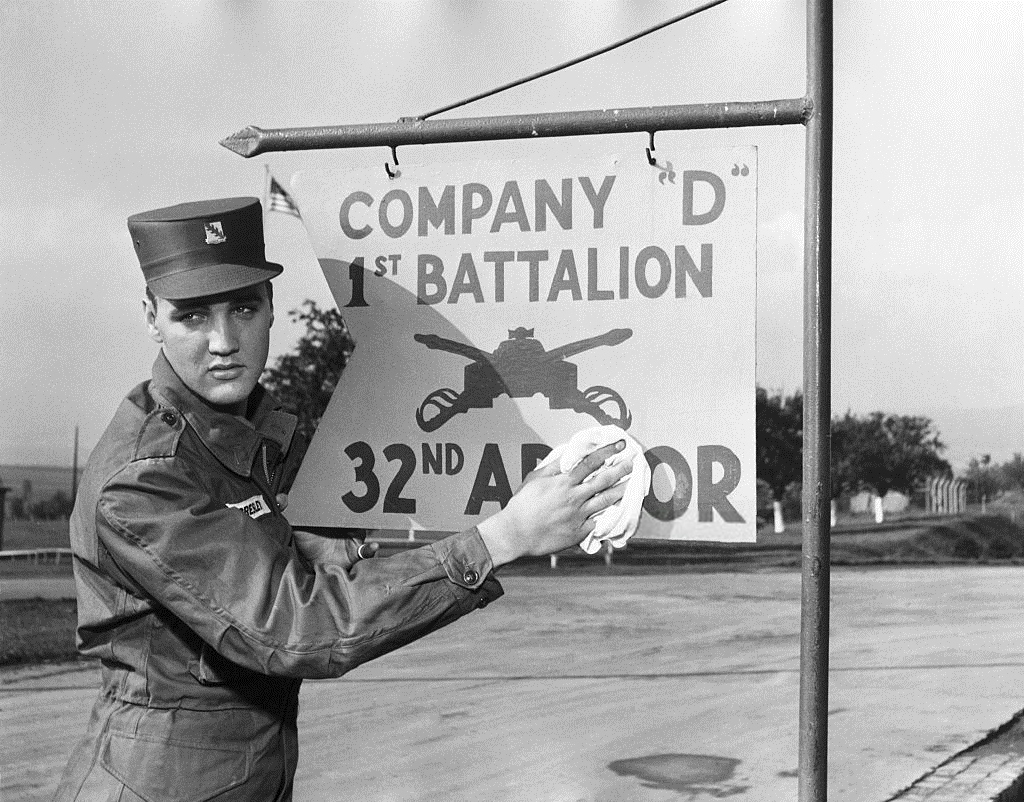
On March 26, 1958, as Roger worked his way through the spring semester at college, he turned nineteen years old.
Two days earlier, on Monday, March 24, 1958, in Memphis, Tenn., the biggest rock’n’roll star in the world, Elvis Presley, entered military service with the United States Army. Elvis would spend nearly two years on active duty in the Army, first at Fort Hood, Texas, then from October 1958 until March 1960 in Germany, away from recording studios and concert stages.
At the time, the two events – one involving a small-town kid from California; the other involving a small-town kid from Mississippi – didn’t appear to have any connection to each other. A little more than a year later, the connection would change Roger Strunk’s life forever.
During the Summer of 1958, he packed up his belongings and headed south down Highway 99 to enroll at Fresno State College in the city where he was born.
Now a bit more distant from his parents and sisters back in Tracy, but still with numerous aunts, uncles and cousins in and around Fresno, Roger plunged into his sophomore year with both feet, clearly a young man with a plan – or at least a bright idea – for his future.

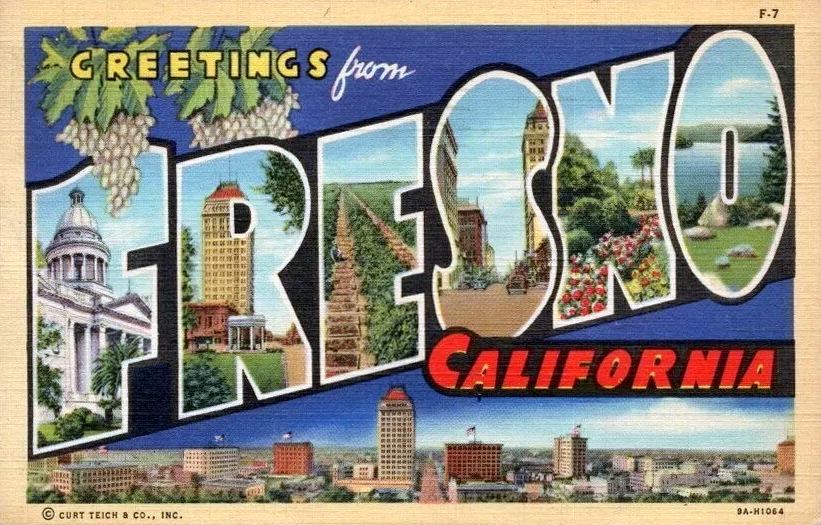
If Stockton wasn’t the first place you’d think of as a stepping stone to Hollywood, then Fresno would not be much higher on the list. Nonetheless, that’s where Roger Strunk decamped in Summer 1958, back to the city where he was born just nineteen years earlier – and where his path to success would accelerate at a lightning-fast pace in just a matter of months.
Somewhere between the end of his freshman year at Stockton College and the start of his sophomore year at Fresno State, Roger began appearing in local clubs, singing to make a few extra bucks.
“I’d always sing, mostly in small clubs or on the local TV station for ten or fifteen bucks,” he told Jack Holland in 1962 for a retrospective on his nascent career.
While the names of those small clubs may be lost to time, at least one of his early television appearances was significant enough to earn mention in the local Fresno Bee newspaper.
On the weekend of August 14, 1958, Fresno’s KJEO-TV (Channel 47) staged a seventeen-hour telethon to support United Cerebral Palsy, beginning at 10 PM on Saturday night. Among the stars appearing on the broadcast were George Reeves, the star of television’s popular “Superman” series, and Los Angeles Rams star Elroy (Crazylegs) Hirsch, who had recently retired from his Hall of Fame football career to embark on the next chapter of his life.
Also on the telethon lineup were numerous local acts, including Patricia (Pat) Markarian’s orchestra, “with Roger Strunk, vocalist,” as well as a vocal group known as The Buddies.
The inclusion of both Roger Strunk and The Buddies on the telethon would prove to be a little piece of kismet, or serendipity at the very least, as it would provide one more puzzle piece toward the creation of Rod Lauren.
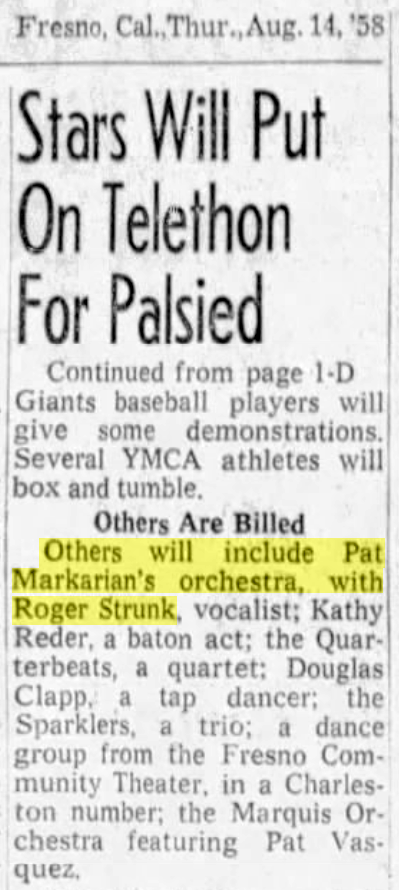
The leader of The Buddies, a Fresno ensemble, was an aspiring songwriter named Don Gross. He and his bandmates – Peter Eastman, Billy Manzo and George Luft – had recorded a few songs for Decca in 1956, including “The Most Happy Fella” from Frank Loesser’s musical of the same name, and the group’s own composition, “Two Skeletons On A Tin Roof,” for which all four Buddies shared a writing credit.
In the wake of their appearances on the telethon, Gross approached Roger and asked if he would be willing to perform a few of the songs he had written.
Sources diverge at this point – Roger either recorded Gross’ songs on a demo disc, or appeared at a local nightspot to sing them before a live audience.
To be continued…
Written by
David Ferrell Jackson
“I Dreamed” Cover Art: Concept by David Ferrell Jackson · Photo Illustration by Zahid Amin · Based on 1959 “I’m Rod Lauren” cover art (LSP-2176) courtesy of RCA Victor Records.


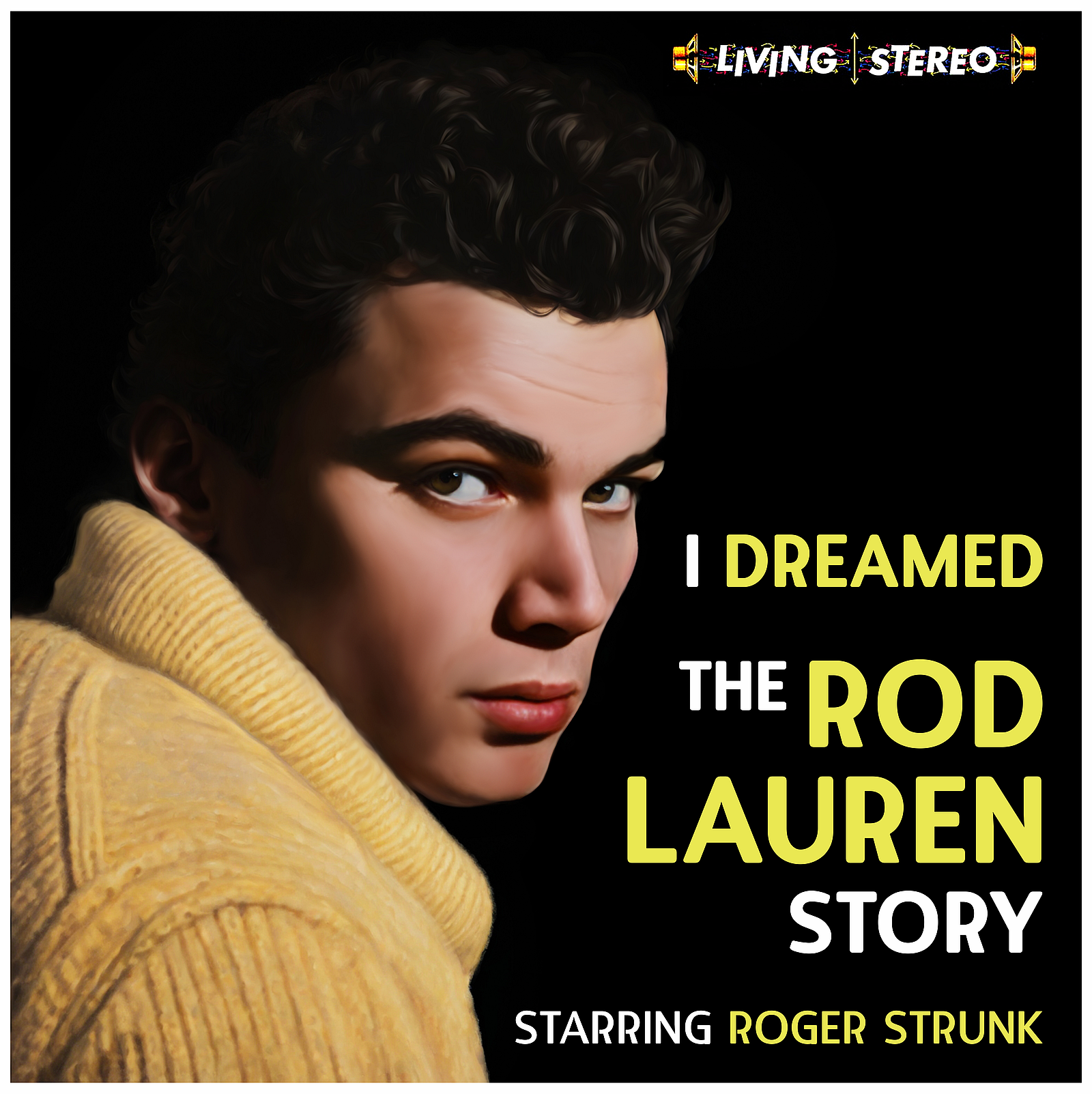
2 responses to “I Dreamed: The Rod Lauren Story”
D.J., will this biography include his life after records, TV, and movies? I know it was not good for all those years. I have read that he lived in a homeless shelter when he returned to California from the Phillipines. And about the suicide. I am not passing judgement on him about whatever happened in regard to his wife. I am just sorry that he had a promisng career that got sidetracked.
Thank you for this. I look forward to reading the “to be continued”.